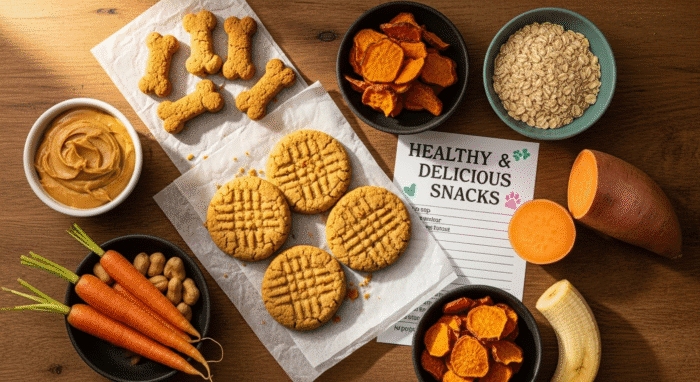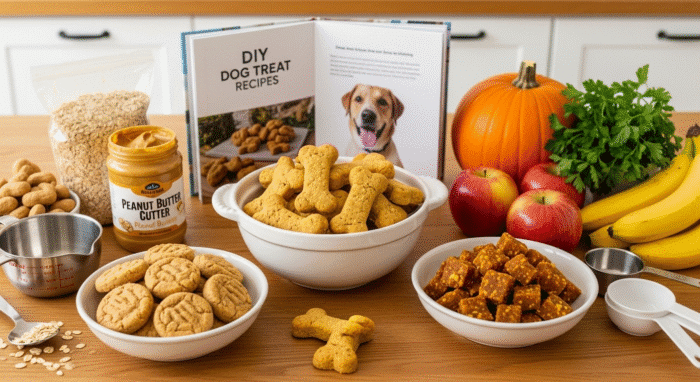Okay, let’s be honest. We all spoil our dogs a little (or a lot!). And what better way to show them some love than with homemade treats? I mean, those store-bought ones… who knows what’s really in them? But the thought of constantly baking? Yeah, that’s a commitment. So, I’ve been on a mission to find ridiculously easy DIY dog treat recipes that are actually healthy. Because let’s face it, a treat is only a treat if it’s, well, a treat for their bodies too!
The good news? It’s surprisingly simple. Forget complicated baking techniques. We’re talking minimal ingredients, minimal effort, and maximum tail wags. Think of it like canine cooking for dummies (no offense, pups!). Ready to ditch the mystery ingredients and get your bake on? Or, well, mostly bake?
Table of Contents
Peanut Butter Banana Bites: A Classic for a Reason

This recipe is practically legendary in the dog treat world. It’s a crowd-pleaser, and so easy a kid could make it. Seriously. You probably already have the ingredients in your pantry. Here’s what you need:
- 1 ripe banana (the spottier, the better!)
- 1/2 cup peanut butter (make sure it’s xylitol-free! Xylitol is super toxic to dogs.)
- 1 1/2 cups rolled oats
Instructions are simple. Mash the banana, mix in the peanut butter, stir in the oats. Roll into bite-sized balls (or use a tiny cookie cutter for extra flair!), and bake at 350°F (175°C) for about 12-15 minutes. Let them cool completely before letting your furry friend go to town. Store them in an airtight container in the fridge for up to a week.
I’ve got to admit, the smell of these baking is pretty amazing. My own dog, a stubborn little beagle, practically drools at my feet when these are in the oven. And I feel good knowing exactly what she’s eating.
Frozen Watermelon Pupsicles: Summer Cool-Down
Okay, this isn’t technically baking, but it’s still a treat! And perfect for hot summer days. My dog loves it when it’s hot outside. It’s unbelievably refreshing, hydrating, and uses just one ingredient: watermelon! Though, you could get creative and add a little bit of blueberry.
Cut the watermelon into chunks, remove any seeds (very important!), and blend it until smooth. Pour the mixture into ice cube trays or popsicle molds (bone-shaped ones are a fun touch, but totally optional). Freeze for at least 3-4 hours, or until solid. Hand one over to your pup and watch them go to town.
Just a heads-up: these can get a little messy! Maybe serve them outside or on an easy-to-clean surface.
This is a great way to keep your dog cool, but remember that too much watermelon can cause an upset stomach because of the fruit sugar, so give these in moderation!
Sweet Potato Chews: Healthy & Chewy
Sweet potatoes are nutritional powerhouses! They’re packed with vitamins, fiber, and antioxidants. And they make a surprisingly satisfying chew for dogs. Here’s the thing though: getting the texture right is key.
Preheat your oven to 250°F (120°C). Wash and slice sweet potatoes into 1/4-inch thick rounds. You can peel them if you want, but the skin is nutritious too. Place the slices on a baking sheet lined with parchment paper. Bake for 3-4 hours, flipping them halfway through, until they’re chewy but not brittle. The cooking time can vary depending on your oven and the thickness of the slices, so keep an eye on them.
Let them cool completely and store them in an airtight container. These can last for a couple of weeks. These chews are fantastic for dental health and keeping your dog occupied. But, just like with any chew toy, supervise your dog while they’re enjoying them.
And speaking of keeping your dog occupied, you might want to check out DIY Dog Enrichment: Fun & Engaging Activities for Bored Pups. Boredom can lead to all sorts of problems, so keeping them mentally stimulated is super important!
The “Why” Behind Homemade Treats (And What to Watch Out For)
I initially thought making my own dog treats was just about saving money. And, yeah, it can be! But the real benefit is knowing exactly what’s going into your dog’s food. No weird preservatives, artificial colors, or mystery ingredients. You’re in control.
But here’s the thing: not all human foods are safe for dogs. Chocolate, grapes, raisins, onions, garlic, and avocados are all toxic. And, as mentioned before, xylitol is a definite no-go. Always double-check the ingredients before you start baking.
Also, remember that treats should only make up a small portion of your dog’s daily diet. They’re treats, not meals. Too many treats can lead to weight gain and other health problems.
Speaking of health problems, did you know that certain breeds are predisposed to specific issues? For example, if you have an English Bulldog, you might want to read up on English Bulldog Health Guide: Preventing Respiratory Issues. Prevention is always better than cure!
FAQ: Your Burning Dog Treat Questions Answered
How do I know if my dog has a food allergy, and could that impact the treat recipes I choose?
That’s a super important question! Food allergies in dogs can manifest in various ways, including skin issues (itching, redness), digestive problems (vomiting, diarrhea), and even ear infections. If you suspect your dog has a food allergy, the best course of action is to consult with your vet. They can perform allergy testing or recommend an elimination diet to identify the culprit ingredient. Once you know what your dog is allergic to, you can carefully select treat recipes that avoid those ingredients. Always read labels carefully, even when making your own treats, to ensure there’s no cross-contamination.
Can I use honey or maple syrup as a natural sweetener in DIY dog treat recipes?
Yes, both honey and maple syrup can be used in small amounts as natural sweeteners in dog treats. However, moderation is key! Both are high in sugar, which can contribute to weight gain and dental problems if given in excess. A teaspoon or two in a batch of treats is generally fine. It is worth noting that puppies, senior dogs or those with a medical condition such as diabetes should not be given these treats without veterinarian approval.
My dog is a picky eater. Any tips for making these treats more appealing?
Ah, the picky eater challenge! I get it. First, make sure the treats are soft and easy to chew, especially for senior dogs. Second, try using ingredients your dog already loves. If they go crazy for chicken, add a little shredded cooked chicken to a treat recipe. If they’re obsessed with cheese, incorporate a small amount of grated cheese. You can also try different shapes and sizes. Sometimes, just making the treats look more appealing can do the trick. Finally, offer the treat with lots of enthusiasm and praise. Your excitement might be contagious!
What’s the best way to store homemade dog treats to keep them fresh?
Proper storage is essential for keeping your DIY dog treat recipes both fresh and safe for your pup. For treats that are dry and don’t contain perishable ingredients (like the sweet potato chews), an airtight container at room temperature is usually fine. They’ll typically last for a week or two. For treats that contain moist ingredients (like the peanut butter banana bites), it’s best to store them in the refrigerator in an airtight container. These will last for about a week. And for the frozen pupsicles, obviously, keep them in the freezer!

